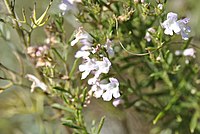
Photo from wikipedia
BACKGROUND Chagas disease (American Trypanosomiasis) is classified by the World Health Organization (WHO) as one of the seventeen neglected tropical diseases (NTD), affecting, mainly, several regions of Latin America. INTRODUCTION… Click to show full abstract
BACKGROUND Chagas disease (American Trypanosomiasis) is classified by the World Health Organization (WHO) as one of the seventeen neglected tropical diseases (NTD), affecting, mainly, several regions of Latin America. INTRODUCTION However, immigration has expanded the range of this disease to other continents. Thousands of patients with Chagas disease die annually, yet no new therapeutics for Chagas disease have been approved, with only nifurtimox and benznidazole available. Treatment with these drugs presents several challenges, including protozoan resistance, toxicity, and low efficacy. Natural products, including the secondary metabolites found in plants, offer a myriad of complex structures that can be sourced directly or optimized for drug discovery. METHOD Therefore, this review aims to assess the literature from the last 10 years (2011 - 2021) and present the anti-T. cruzi compounds isolated from plants in this period, as well as briefly discuss computational approaches and challenges in natural product drug discovery. Using this approach, more than 350 different metabolites were divided based on their biosynthetic pathway - alkaloids, terpenoids, flavonoids, polyketides, and phenylpropanoids which displayed activity against different forms of this parasite - epimastigote, trypomastigote and more important, the intracellular form, amastigote. CONCLUSION In this aspect, there are several compounds with high potential which could be considered as a scaffold for the development of new drugs for the treatment of Chagas disease - for this, more advanced studies must be performed including pharmacokinetics (PK) and pharmacodynamics (PD) analysis as well as conduction of in vivo assays, these being important limitations in the discovery of new anti-T. cruzi compounds.
Journal Title: Current topics in medicinal chemistry
Year Published: 2022
Link to full text (if available)
Share on Social Media: Sign Up to like & get
recommendations!